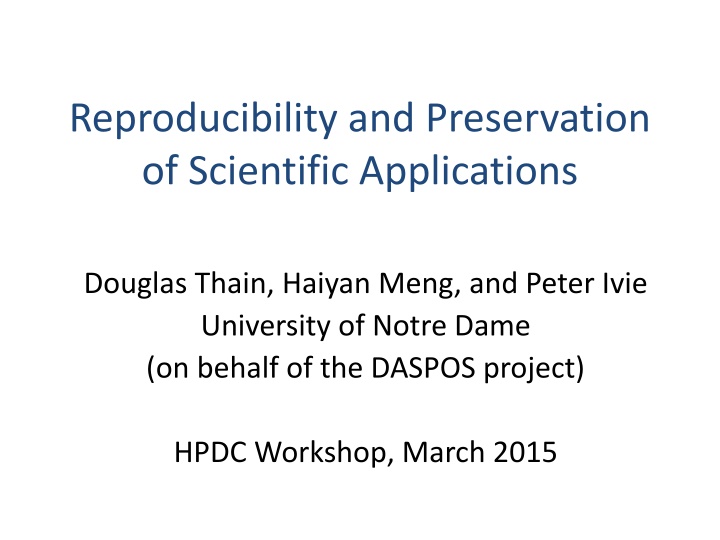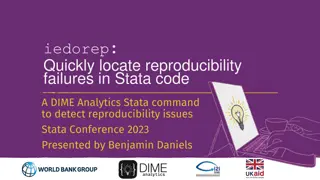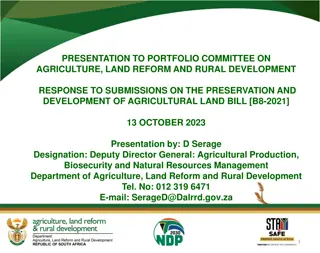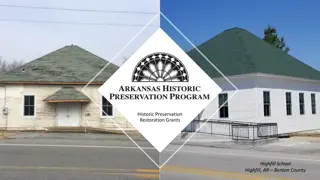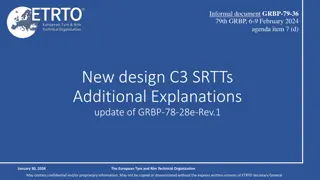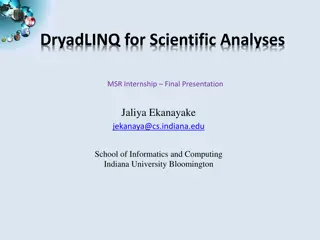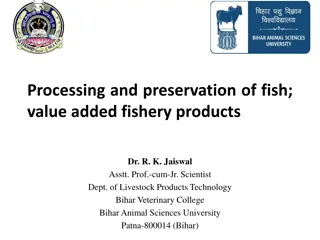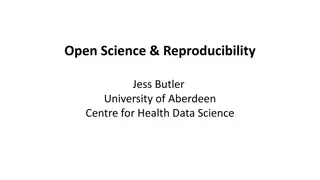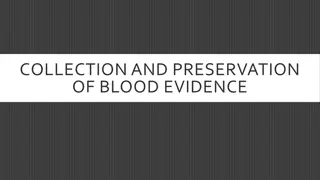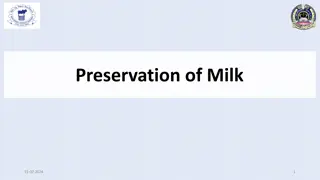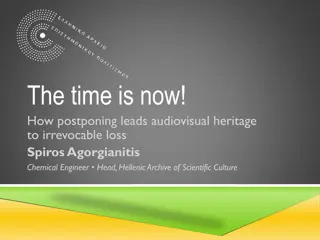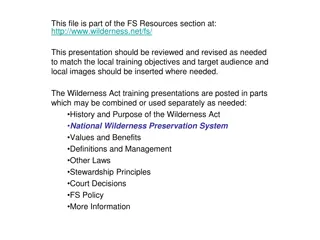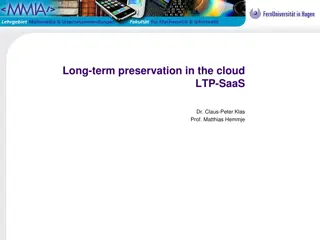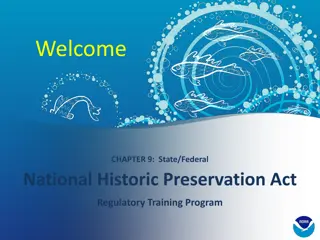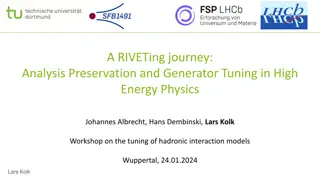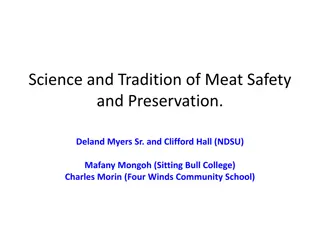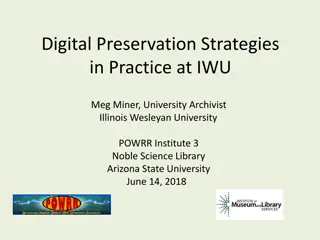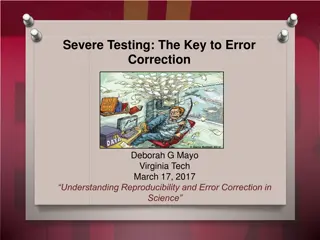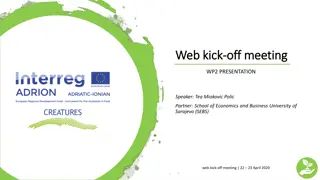Reproducibility and Preservation of Scientific Applications
"This paper, presented at the HPDC Workshop in March 2015, explores the critical aspects of reproducibility and preservation in scientific applications. The authors, Douglas Thain, Haiyan Meng, and Peter Ivie from the University of Notre Dame, discuss the challenges and strategies for ensuring the reliability and longevity of research outcomes. The DASPOS project aims to enhance the understanding and practices for maintaining the integrity of scientific work. The importance of reproducibility in scientific research is emphasized, highlighting the need for robust methodologies and tools for preserving data and code."
Download Presentation

Please find below an Image/Link to download the presentation.
The content on the website is provided AS IS for your information and personal use only. It may not be sold, licensed, or shared on other websites without obtaining consent from the author.If you encounter any issues during the download, it is possible that the publisher has removed the file from their server.
You are allowed to download the files provided on this website for personal or commercial use, subject to the condition that they are used lawfully. All files are the property of their respective owners.
The content on the website is provided AS IS for your information and personal use only. It may not be sold, licensed, or shared on other websites without obtaining consent from the author.
E N D
Presentation Transcript
Reproducibility and Preservation of Scientific Applications Douglas Thain, Haiyan Meng, and Peter Ivie University of Notre Dame (on behalf of the DASPOS project) HPDC Workshop, March 2015
The Cooperative Computing Lab University of Notre Dame http://www.nd.edu/~ccl
www.daspos.org DASPOS Project
Reproducibility is the cornerstone of the scientific method. Can we really claim to be conducting science?
Reproducibility in e-Science is absolutely terrible today! Can I re-run a result from a colleague from five years ago successful, and obtain the same result? How about a student in my lab? Today, are we preparing for our current results to be re-used by others five years from now? Multiple reasons why not: Rapid technological change. No archival of artifacts. Many implicit dependencies. Lack of backwards compatibility. Lack of social incentives.
Many different Rs Reproduce precisely what someone else did on the same resources, with the same techniques. Recreate an equivalent computation on different resources, with similar techniques. Repurpose an experiment by running it again with a slight change to the data, software, or environment. Reuse the same artifact across many different experiments, for a longitudinal comparison. Rely on one party to set up an environment and make it usable for multiple parties. (Think sysadmins.) Other Rs?
Typical Computing Experiment PI gives student some general directions. Student writes some code, does some experiments, saves the outputs, writes the paper. Source code is often carefully curated. But what about the operating system, the software dependencies, the experimental configuration, the input data, etc If we did manage to re-run everything, do we have a means of verifying equivalence? Concurrency + Floating Point != Bitwise Equality.
Preserve the Mess or Encourage Organization? (let s do some of each)
Preserve the Mess: Stick it all into a VM sim.exe input.dat p 5 out output.dat sim.exe input.dat p 5 out output.dat Sim Sim File File File File File File Kernel Kernel VM Image
Preserve the Mess: Stick it all into a VM A good place to start, however: Captures more things than necessary. For many experiments will duplicate large amounts of software/data in the VM images. Hard to disentangle things logically what if you want to run the same experiment with some component of the OS/software/data changed? Doesn t capture network interactions. May be coupled to specific a VM technology. VMs are not the place to archive data.
Preserve the Mess: Trace All Interactions sim.exe input.dat p 5 out output.dat sim.exe input.dat p 5 out output.dat Sim Sim Parrot File File File File File Observe all System calls At runtime. (also CDE/PTU) Kernel http://some.archive.com/mydata A portable package that can be re-executed using Docker, Parrot, or Amazon
Preserve the Mess: Trace All Interactions Solves some problems: Only captures what is actually used. Once captured, not coupled to a technology. Observes network dependencies. But not all of them: For many experiments will duplicate large amounts of software/data in the VM/package images. Hard to disentangle things logically what if you want to run the same experiment with some component of the OS/software/data changed. VMs/packages are not the place to archive data.
What we really want: A structured way to compose an application with all of its dependencies. Enable preservation, but also re-use of data and images for efficiency.
myenv1.json Umbrella kernel = { } opsys = { } software = { simulator = { } data = { input = { calib = { } name = Linux ; version = 83.21.blue.42 umbrella run myenv1.json name = RedHat ; version = 6.1 Mysim 3.1 calib input mount = /soft/sim ; name = mysim-3.1 ; RedHat 6.1 Linux 83.21.blue.42 Online Data Archives mount = /data/input ; url = http://some.url ; } RedHat 6.1 Mysim 3.1 mount = /data/calib ; url = http://other.url ; } Mysim 3.2 RedHat 6.2
Umbrella specifies a reproducible environment while avoiding duplication and enabling precise adjustments. Same thing, but use different input data. Same thing, but update the OS Run the experiment input2 input1 input2 Mysim 3.1 Mysim 3.1 Mysim 3.1 RedHat 6.2 RedHat 6.1 RedHat 6.1 Linux 83 Linux 83 Linux 83 Online Data Archive RedHat 6.1 input1 Linux 83 input2 Mysim 3.1 Mysim 3.2 Linux 84 RedHat 6.2 calib2 calib1
Specification is More Important Than Mechanism Current version of Umbrella can work with: Docker create container, mount volumes. Parrot Download tarballs, mount at runtime. Amazon allocate VM, copy and unpack tarballs. Condor Request compatible machine. More ways will be possible in the future as technologies come and go. Key requirement: Efficient runtime composition, rather than copying. (Compare to Dockerfile.)
How do we construct complex workflows from these building blocks?
PRUNE Preservation Run Environment Problem: Our user interfaces do not accurately capture the dependencies or the environment of the codes that we run. Can we improve upon the standard command- line shell interface to make it reproducible? Re-use a good idea: functional representation. output = mysim( input, calib ) USING ENV myenv.json Build on ideas from GridDB, VDL, Swift, Taverna, Galaxy, but focus is on precise reproduction, not on performance. (Coarse granularity.)
PRUNE Preservation Run Environment PUT /tmp/input1.dat AS input1 PUT /tmp/input2.dat AS input2 PUT /tmp/calib.dat AS calib PUT sim.function AS sim [gets id 3ba8c2] [gets id dab209] [gets id 64c2fa] [gets id fffda7] out1 = sim( input1, calib ) IN ENV myenv1.json [out1 is bab598] out2 = sim( input1, calib ) IN ENV myenv2.json [out2 is 392caf] out3 = sim( input2, calib ) IN ENV myenv2.json [out3 is 232768]
PRUNE connects together precisely reproducible executions and gives each item a unique identifier output1 = sim( input1, calib1 ) IN ENV myenv1.json input1 sim2 output 1 sim calib1 myenv1 myenv1 Bab598 = fffda7 ( 3ba8c2, 64c2fa ) IN ENV c8c832 Online Data Archive RedHat 6.1 input1 Linux 83 outpu11 Mysim 3.1 Mysim 3.2 Linux 84 RedHat 6.2 myenv1 calib1
All Sorts of Open Problems Naming: Tension between usability and durability. At least two levels of naming. What is the intersection of version control (doc deltas) and provenance (doc ops) ? Usability: Can we accommodate existing work patterns, or do we force new habits? Repositories: Who will run them, how many should we have, what will they cost ? Compatibility: Can we work in existing workflow technologies without starting over? Composition: MPI, BoT, Workflows, Map-Reduce,
Portability and Reproducibility Observation by Kevin Lannon @ ND: Portability and reproducibility are two sides of the same coin. Both require that you know all of the input dependencies and the execution environment in order to save it, or move to the right place. Workflow systems: Force us to treat tasks as proper functions with explicit inputs and outputs. Key issue: Identify and name common dependencies, rather than saving everything independently.
Is Reproducibility About Technology or Sociology?
Acknowledgements CCL Team Ben Tovar Patrick Donnelly Peter Ivie Haiyan Meng Nick Hazekamp Peter Sempolinski Haipeng Cai Chao Zheng Haiyan Meng is leading work on Parrot and Umbrella. Peter Ivie is leading the work on PRUNE. nsf_logo 25
Douglas Thain dthain@nd.edu Cooperative Computing Lab http://ccl.cse.nd.edu
